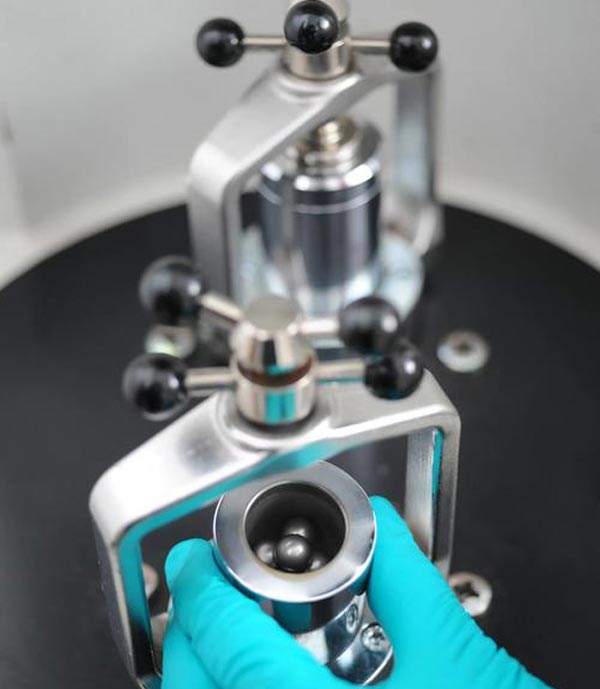More Sustainability with Mechanochemistry

Ball Mill
Credit: Frank Vinken / Max-Planck-Institut für Kohlenforschung
Flour, coffee or spices: Many people know the principle of a mill from the kitchen. But special mills are also used for research purposes in the laboratories of the Max-Planck-Institut für Kohlenforschung. The scientists are convinced that mechanochemistry can make the chemical industry more sustainable.
How is it possible to make the production of chemicals less expensive and, above all, more sustainable? This question is playing an important role in the chemical industry and in pharmaceutical companies. Scientists at the Max-Planck-Institut für Kohlenforschung are doing their best to make chemical reactions as environmentally friendly and economically viable as possible – not only in the lab, but also on an industrial scale. For one of those projects the Felderhoff group, Department of Heterogeneous Catalysis, has now received a grant of 500,000 euros. Ball mills play an important role in this case.
“We are just getting started with our new research project named IMPACTIVE,” explains Michael Felderhoff. This project is about transferring mechanochemical processes to large-scale production. IMPACTIVE combines the expertise and knowledge from two COST networks and will develop new environmentally friendly methods for manufacturing active pharmaceutical ingredients (APIs) using mechanochemistry as a disruptive technology. The advantages of mechanochemistry include: no solvent use, high efficiency, low cost, lower energy consumption and lower CO2 emissions. Mechanochemistry uses mechanical processes such as ball milling, twin-screw extrusion, acoustic resonance mixing and spray drying to trigger chemical reactions. The principle of a ball mill to activate a chemical reaction is quite simple, for example. Reagents are placed in a grinding chamber together with grinding media. Through rotation or vibration, collisions occur between balls and chemicals. By transferring mechanical energy to the reagents, they are activated and a chemical reaction can take place.
With the help of such a ball mill, a team at the MPI has recently succeeded in synthesizing ammonia under much milder conditions than with the commercial Haber-Bosch process. The researchers were thus able to show that mechanochemistry can also offer an interesting perspective for economically important products such as ammonia. “It is therefore obvious that other research projects are having a look at mechanochemistry,” explains Michael Felderhoff.
The European “IMPACTIVE” project involves 18 partners from science and industry with a project duration of 48 months. The work of the “Mech@SusInd” (Mechanochemistry for Sustainable Industry) group within the COST research network is similar. This network, which has been in existence since 2019, currently includes 38 participating countries and 87 university and research institutions worldwide. “During this time, we have built a multidisciplinary network of European scientists, engineers, technologists, entrepreneurs, industrialists and investors,” says Michael Felderhoff. Again, the long-term goal is to increase the use of mechanical activation in the production of chemicals.
One thing is clear, Michael Felderhoff believes: If the chemical industry wants to continue to play a leading role in developing key technologies for the major challenges facing our society, new paths must be taken. Felderhoff and the other members of the Mech@SusInd group are convinced that mechanochemical processes have the potential to change chemical production processes and make them more environmentally friendly.
Wissenschaftliche Ansprechpartner:
Dr. Michael Felderhoff
Research Group Leader
+49 208/306-2450
+49 208/306-2989
felderhoff@kofo.mpg.de
Media Contact
All latest news from the category: Life Sciences and Chemistry
Articles and reports from the Life Sciences and chemistry area deal with applied and basic research into modern biology, chemistry and human medicine.
Valuable information can be found on a range of life sciences fields including bacteriology, biochemistry, bionics, bioinformatics, biophysics, biotechnology, genetics, geobotany, human biology, marine biology, microbiology, molecular biology, cellular biology, zoology, bioinorganic chemistry, microchemistry and environmental chemistry.
Newest articles

Innovative 3D printed scaffolds offer new hope for bone healing
Researchers at the Institute for Bioengineering of Catalonia have developed novel 3D printed PLA-CaP scaffolds that promote blood vessel formation, ensuring better healing and regeneration of bone tissue. Bone is…

The surprising role of gut infection in Alzheimer’s disease
ASU- and Banner Alzheimer’s Institute-led study implicates link between a common virus and the disease, which travels from the gut to the brain and may be a target for antiviral…

Molecular gardening: New enzymes discovered for protein modification pruning
How deubiquitinases USP53 and USP54 cleave long polyubiquitin chains and how the former is linked to liver disease in children. Deubiquitinases (DUBs) are enzymes used by cells to trim protein…



